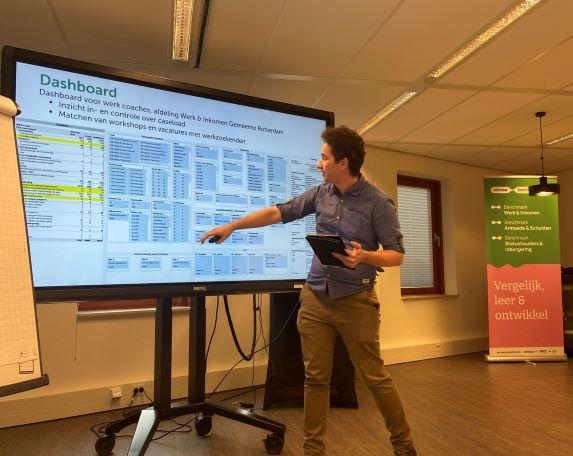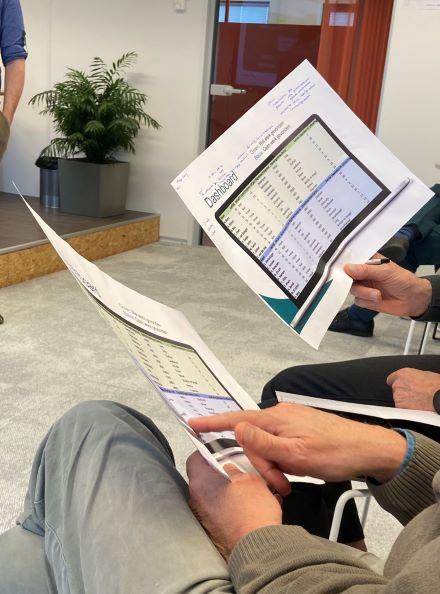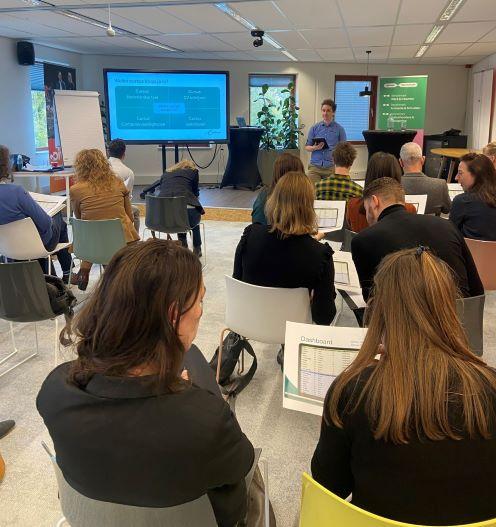For this year’s Divosa Benchmark Festival, Margot Kersing was asked by the organizing team to give two rounds of workshops on data driven working in the social domain to the participants, all working for municipalities or other organizations in the social domain. The workshops formed part of the broader programme of the Divosa benchmark festival which was kicked-off by plenary talks from the National Ombudsman, Reinier van Zutphen, prof. dr. Menno Fenger from Erasmus University, and social entrepreneur Martine van Ommeren about the role of the municipality.
 The workshops started with a presentation by Margot about their research on the data dashboard of the Work & Income Department at the City of Rotterdam and the key lessons learned. Margot showed convincingly how the use of such a data dashboard influences the work coaches and how that in turn influences the quality and usefulness of the data dashboard.
The workshops started with a presentation by Margot about their research on the data dashboard of the Work & Income Department at the City of Rotterdam and the key lessons learned. Margot showed convincingly how the use of such a data dashboard influences the work coaches and how that in turn influences the quality and usefulness of the data dashboard.
Before deciding to use or create such a big data tool, it is therefore essential for municipalities to critically ask themselves, whether such a data tool is desirable, necessary, and feasible. The next step is to talk to the people who will actually use such a data tool: the frontline bureaucrats. How do they understand their own role? What skills and knowledge to they have? Do you need to offer them trainings to learn how to work with the data tool? How do you make sure that they do not spend most of their time working with- and improving the tool? Thirdly, municipalities must make sure that the data that goes into the tool is ‘clean’, meaning correct, complete and up-to-date. The latter is something one of the participants, a data analyst at a smaller municipality, struggled with regularly.
 After the presentation, participants got to work themselves. With the help of a simplified fictional dashboard, participants put themselves in the shoes of a work coach and in groups of two had to discuss, firstly, which workshop they should buy to offer their clients (there was a choice between Dutch, Computer Skills, CV writing, and applying for jobs) and secondly, which client to send a vacancy.
After the presentation, participants got to work themselves. With the help of a simplified fictional dashboard, participants put themselves in the shoes of a work coach and in groups of two had to discuss, firstly, which workshop they should buy to offer their clients (there was a choice between Dutch, Computer Skills, CV writing, and applying for jobs) and secondly, which client to send a vacancy.
In both groups, discussions quickly emerged about the limit of such a data tool to make these decisions. “There is more that you cannot see then what you can see,” one participant voiced his frustration. Participants were quick to suggest changes to the dashboard, asking to include language and other skills, availability for work and health factors, but the request to attach a transcript of a conversation with the client was met with most applause.
Discussions also emerged how one could measure the impact of such a data tool. The outflow of job seekers does not say anything about how good the work coaches do their job because some caseloads are more difficult than others. Some unemployed benefit recipients need a lot of help whereas others are more self-reliant and will find a job quicker. Outflow numbers also do not say anything about the sustainability of outflow. It might be the case that people who found a job circle back into unemployment. The question also emerged whether a big data tool is needed at all, for example in smaller municipalities with smaller caseloads. Margot pointed out that the idea for a data dashboard emerged as a solution for dealing with the high caseloads of work coaches in Rotterdam (which were around 120 per work coach at the time). A data tool can potentially help work coaches in their work but does not address the more structural underlying problems of not financing enough work coaches to deal with the high caseloads, which remains a political decision. Furthermore, the participants struggled to imagine a data tool precise enough to help everyone but saw the potential of using the data tool to help most clients which do fit in the system and then offer more customized help to the remaining clients. Here the data tool can also be pitfall, as some groups of people might be less visible in the system (for example being an informal care giver is not one of the boxes to be ticked in the data dashboard) and thus not receive the extra support they need.

The workshop allowed the participants, most of whom were policy officers or strategic advisors, to explore the role of and emphasize with frontline officers. It also equipped them with the questions and tools to critically assess the data tools they are already using or are planning to use in the future.
